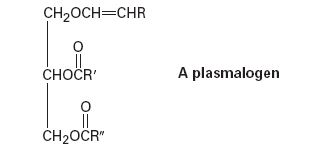
ORGANIC CHEMISTRY-EBOOK>I<
9th Edition
ISBN: 9781305084414
Author: McMurry
Publisher: INTER CENG
expand_more
expand_more
format_list_bulleted
Concept explainers
Textbook Question
Chapter 27.SE, Problem 22AP
The plasmalogens are a group of lipids found in nerve and muscle cells. How do plasmalogens differ from fats?

Expert Solution & Answer
Want to see the full answer?
Check out a sample textbook solution
Students have asked these similar questions
Help w c!
Can someone help me understand this?
help w d!
Chapter 27 Solutions
ORGANIC CHEMISTRY-EBOOK>I<
Ch. 27.1 - Carnauba wax, used in floor and furniture...Ch. 27.1 - Draw structures of glyceryl tripalmitate and...Ch. 27.2 - Prob. 3PCh. 27.2 - Write the saponication reaction of glyceryl...Ch. 27.4 - Prob. 5PCh. 27.5 - Prob. 6PCh. 27.5 - Prob. 7PCh. 27.6 - Draw the following molecules in chair...Ch. 27.6 - Lithocholic acid is an A–B cis steroid found in...Ch. 27.7 - Prob. 10P
Ch. 27.SE - Prob. 11VCCh. 27.SE - Propose a biosynthetic pathway for the...Ch. 27.SE - Identify the following fatty acid, and tell...Ch. 27.SE - Prob. 14MPCh. 27.SE - Prob. 15MPCh. 27.SE - Prob. 16MPCh. 27.SE - Prob. 17APCh. 27.SE - Fats can be either optically active or optically...Ch. 27.SE - Prob. 19APCh. 27.SE - Show the products you would expect to obtain from...Ch. 27.SE - Draw a Newman projection along the C2-C3 bond of...Ch. 27.SE - The plasmalogens are a group of lipids found in...Ch. 27.SE - Prob. 23APCh. 27.SE - Prob. 24APCh. 27.SE - Prob. 25APCh. 27.SE - Prob. 26APCh. 27.SE - Prob. 27APCh. 27.SE - Prob. 28APCh. 27.SE - Prob. 29APCh. 27.SE - Assume that acetyl CoA containing a 14C isotopic...Ch. 27.SE - Assume that acetyl CoA containing a 14C isotopic...Ch. 27.SE - Assume that acetyl CoA containing a 14C isotopic...Ch. 27.SE - Assume that acetyl CoA containing a 14C isotopic...Ch. 27.SE - Prob. 34APCh. 27.SE - Draw the most stable chair conformation of...Ch. 27.SE - Draw the most stable chair conformation of...Ch. 27.SE - Prob. 37APCh. 27.SE - Prob. 38APCh. 27.SE - Prob. 39APCh. 27.SE - What product would you obtain by reduction of...Ch. 27.SE - Prob. 41APCh. 27.SE - Eleostearic acid, C18H30O2, is a rare fatty acid...Ch. 27.SE - Prob. 43APCh. 27.SE - Prob. 44APCh. 27.SE - Propose a synthesis of diethylstilbestrol (Problem...Ch. 27.SE - Prob. 46APCh. 27.SE - Cembrene, C20H32, is a diterpenoid hydrocarbon...Ch. 27.SE - α-Fenchone is a pleasant-smelling terpenoid...Ch. 27.SE - Prob. 49APCh. 27.SE - Propose a mechanism for the biosynthesis of the...
Additional Science Textbook Solutions
Find more solutions based on key concepts
How could you separate a mixture of the following compounds? The reagents available to you are water, either, 1...
Organic Chemistry (8th Edition)
6. How can you use the features found in each chapter?
Human Anatomy & Physiology (2nd Edition)
56. Global Positioning System. Learn more about the global positioning system and its uses. Write a short repo...
The Cosmic Perspective (8th Edition)
Give the IUPAC name for each compound.
Organic Chemistry
1. Genetics affects many aspects of our lives. Identify three ways genetics affects your life or the life of a ...
Genetic Analysis: An Integrated Approach (3rd Edition)
Label each statement about the polynucleotide ATGGCG as true or false. The polynucleotide has six nucleotides. ...
General, Organic, and Biological Chemistry - 4th edition
Knowledge Booster
Learn more about
Need a deep-dive on the concept behind this application? Look no further. Learn more about this topic, chemistry and related others by exploring similar questions and additional content below.Similar questions
- a. Explain Why electron withdrawing groupe tend to be meta-Directors. Your answer Should lyclude all apropriate. Resonance contributing Structures 6. Explain why -ll is an ortho -pura drccton evon though chlorine has a very High Electronegativityarrow_forwardC. Ν Harrow_forwarda. H3C. N H3C CH3 HCNarrow_forward
- ол 2. восцапан (46:00) Curtius rearrangment 1. NaN3, heat -OHarrow_forwardQuestion 1. Please predict the products for each of the following reactions. Clearly show the regiochemistry (Markovnikov vs anti-Markovnikov) and stereochemistry (syn- vs anti- or both). If a mixture of enantiomers is formed, please draw all the enantiomers.arrow_forwardElectrochemistry. Briefly describe the Donnan potential.arrow_forward
- Indicate what the Luther equation is used for?arrow_forwardIndicate one aspect that benefits and another that makes it difficult to use the hydroquinone electrode to measure pH.arrow_forwardAt an electrified interface according to the Gouy-Chapman model, what types of interactions do NOT occur between the ions and the solvent according to this theory?arrow_forward
arrow_back_ios
SEE MORE QUESTIONS
arrow_forward_ios
Recommended textbooks for you

 Chemistry for Today: General, Organic, and Bioche...ChemistryISBN:9781305960060Author:Spencer L. Seager, Michael R. Slabaugh, Maren S. HansenPublisher:Cengage Learning
Chemistry for Today: General, Organic, and Bioche...ChemistryISBN:9781305960060Author:Spencer L. Seager, Michael R. Slabaugh, Maren S. HansenPublisher:Cengage Learning General, Organic, and Biological ChemistryChemistryISBN:9781285853918Author:H. Stephen StokerPublisher:Cengage Learning
General, Organic, and Biological ChemistryChemistryISBN:9781285853918Author:H. Stephen StokerPublisher:Cengage Learning Organic And Biological ChemistryChemistryISBN:9781305081079Author:STOKER, H. Stephen (howard Stephen)Publisher:Cengage Learning,Chemistry: Matter and ChangeChemistryISBN:9780078746376Author:Dinah Zike, Laurel Dingrando, Nicholas Hainen, Cheryl WistromPublisher:Glencoe/McGraw-Hill School Pub Co
Organic And Biological ChemistryChemistryISBN:9781305081079Author:STOKER, H. Stephen (howard Stephen)Publisher:Cengage Learning,Chemistry: Matter and ChangeChemistryISBN:9780078746376Author:Dinah Zike, Laurel Dingrando, Nicholas Hainen, Cheryl WistromPublisher:Glencoe/McGraw-Hill School Pub Co Introductory Chemistry: A FoundationChemistryISBN:9781337399425Author:Steven S. Zumdahl, Donald J. DeCostePublisher:Cengage Learning
Introductory Chemistry: A FoundationChemistryISBN:9781337399425Author:Steven S. Zumdahl, Donald J. DeCostePublisher:Cengage Learning


Chemistry for Today: General, Organic, and Bioche...
Chemistry
ISBN:9781305960060
Author:Spencer L. Seager, Michael R. Slabaugh, Maren S. Hansen
Publisher:Cengage Learning

General, Organic, and Biological Chemistry
Chemistry
ISBN:9781285853918
Author:H. Stephen Stoker
Publisher:Cengage Learning

Organic And Biological Chemistry
Chemistry
ISBN:9781305081079
Author:STOKER, H. Stephen (howard Stephen)
Publisher:Cengage Learning,

Chemistry: Matter and Change
Chemistry
ISBN:9780078746376
Author:Dinah Zike, Laurel Dingrando, Nicholas Hainen, Cheryl Wistrom
Publisher:Glencoe/McGraw-Hill School Pub Co

Introductory Chemistry: A Foundation
Chemistry
ISBN:9781337399425
Author:Steven S. Zumdahl, Donald J. DeCoste
Publisher:Cengage Learning
Lipids - Fatty Acids, Triglycerides, Phospholipids, Terpenes, Waxes, Eicosanoids; Author: The Organic Chemistry Tutor;https://www.youtube.com/watch?v=7dmoH5dAvpY;License: Standard YouTube License, CC-BY